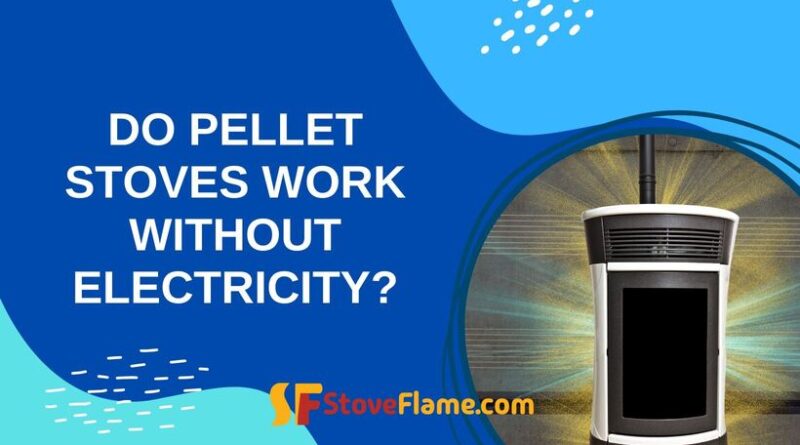Do Pellet Stoves Work Without Electricity?
As the demand for alternative heating sources increases, many homeowners are turning to pellet stoves as a more efficient and eco-friendly option. These stoves use compressed wood or biomass pellets to produce heat, making them a popular choice for those looking to reduce their carbon footprint and save on energy costs.
One question that often comes up is whether pellet stoves can function without electricity. In this article, we aim to provide insights into how pellet stoves work and discuss their dependence on electricity. By examining the different parts of a pellet stove and considering alternative power sources, we hope to offer clarity on this topic. Whether you are interested in off-grid living or preparing for emergencies, understanding the operation of pellet stoves is important. Let’s explore together: Can pellet stoves operate without electricity?
How Do Pellet Stoves Work?
Pellet stoves are a popular and efficient alternative to traditional wood-burning stoves. They work by burning small, compressed pellets made of wood, sawdust, or other biomass materials. These pellets are fed into a hopper, which is then automatically delivered to the combustion chamber by an auger or conveyor system. Inside the combustion chamber, the pellets are ignited and a controlled amount of air is supplied to ensure efficient combustion.
As the pellets burn, they produce heat, which is then distributed throughout the room by a fan or blower. Some pellet stoves even have thermostats that allow you to set the desired temperature, providing convenient and consistent warmth.
The best part is that pellet stoves are highly efficient, with some models boasting efficiency ratings of over 90%. So, if you’re looking for a reliable and eco-friendly way to heat your home, a pellet stove may be a great choice.
Do Pellet Stoves Work Without Electricity?
When considering the use of a pellet stove in situations where electricity may not be available, it is important to understand the role that the type of pellet stove plays. There are two main types of pellet stoves: gravity-fed and electrically powered. Gravity-fed pellet stoves, also known as non-electric or natural draft stoves, rely on natural convection to circulate air and distribute heat. These stoves do not require electricity to operate, making them a reliable option during power outages or off-grid situations.
On the other hand, electrically powered pellet stoves utilize fans and motors to control the combustion process and distribute heat. While these stoves may offer convenient features like automatic ignition and thermostat controls, they do require electricity to function.
Therefore, if you prioritize a pellet stove that can operate without electricity, choosing a gravity-fed model would be the best solution for uninterrupted warmth and comfort.
The Role of Electricity in Pellet Stoves
Although some pellet stoves are designed to operate without electricity, it is important to recognize the significant role that electricity plays in most pellet stoves. Electricity is typically utilized to power essential components such as the auger system, which feeds the pellets into the combustion chamber, and the fans that circulate the warm air throughout the room.
In addition, electrically powered pellet stoves often feature advanced features like programmable thermostats and automatic ignition, which rely on electricity to function.
Therefore, if you are considering a pellet stove and have concerns about power outages or off-grid situations, it is crucial to carefully research and select a gravity-fed or non-electric model that can operate independently.
Pros and Cons of Using Pellet Stoves without Electricity
Using a pellet stove without electricity can have both pros and cons. One of the main advantages is that it provides a heating solution during power outages. In areas prone to frequent blackouts or in off-grid locations, having a pellet stove that can operate independently can ensure continuous warmth and comfort. Additionally, pellet stoves without electricity are often simpler in design, with fewer components that can malfunction or require maintenance. This can result in lower maintenance costs and potentially fewer repairs. However, it is important to note that pellet stoves without electricity may have limited functionality compared to their electric counterparts. Without electric-powered fans, the heat distribution may be less efficient, leading to slower heating of the room.
Additionally, features like programmable thermostats and automatic ignition may not be available in non-electric models. Therefore, it is essential to consider your specific needs and circumstances before deciding on a pellet stove without electricity, weighing the benefits of uninterrupted heating against the potential limitations of functionality.
Tips for Using Pellet Stoves without Electricity
When using a pellet stove without electricity, there are a few tips to keep in mind to optimize its performance. Firstly, ensure you have an adequate supply of pellets on hand. When the stove is not running on electricity, it won’t be able to automatically feed pellets into the burner. Regularly monitor the pellet level and refill as needed to maintain a consistent heat output.
Additionally, consider utilizing alternative methods for distributing heat throughout the room. Without electric-powered fans, placing a heat-resistant fan near the stove can help circulate warm air more effectively.
Another helpful tip is to insulate the area around the stove to minimize heat loss and maximize its heating efficiency. Finally, be prepared to manually ignite the stove using newspaper or fire starters in the absence of automatic ignition. By following these tips, you can make the most of your pellet stove even without electricity.
Factors to Consider
When considering whether a pellet stove will work without electricity, there are several important factors to take into account. First and foremost, it’s crucial to understand the specific model and features of the pellet stove you are considering. Some pellet stoves are designed with backup power options or manual ignition systems, which can allow them to operate during power outages.
Additionally, you should consider the climate and weather conditions in your area. If you live in an area prone to frequent power outages or extreme cold temperatures, having a pellet stove that can function without electricity becomes even more essential.
Lastly, it’s important to assess your own needs and preferences. If you rely heavily on a pellet stove for heat and want a reliable source of warmth during power outages, choosing a model that can operate without electricity may be a top priority.
Alternative Options for Pellet Stoves without Electricity
While pellet stoves typically require electricity to operate, there are alternative options available for those seeking a heating solution during power outages. One option is to invest in a battery backup system specifically designed for pellet stoves. These systems provide a reliable source of power to keep your stove running even when the electricity is down.
Another alternative is to opt for a pellet stove with a manual ignition system. These stoves can be ignited and controlled manually, allowing you to heat your home without relying on electricity.
Additionally, some pellet stove models can be modified to operate with a small generator or an alternative fuel source, such as propane or wood. Exploring these alternative options can provide you with peace of mind and ensure that you have a backup plan in place for heating your home in case of power outages.
Cost and Maintenance
When considering the cost of a pellet stove, it’s important to take into account not only the initial purchase price but also the long-term maintenance expenses. While pellet stoves are generally more affordable than other heating options, such as traditional wood stoves or gas furnaces, there are ongoing costs to consider. These include the price of pellets, which can vary depending on your location and the demand in your area.
Additionally, regular maintenance is necessary to keep your pellet stove in optimal condition. This may involve professional cleaning and inspection, which can incur additional costs. However, proper maintenance ensures that your stove operates efficiently and prolongs its lifespan.
It’s also worth noting that pellet stoves require periodic cleaning of the ash pan and chimney to prevent buildup and ensure safe operation. Taking these factors into consideration will help you budget for the cost and ongoing maintenance of your pellet stove.
Final Thoughts on Using Pellet Stoves without Electricity
In conclusion, using a pellet stove without electricity is indeed possible and can be a viable heating option in certain situations. However, it’s important to understand the limitations and considerations involved. It’s crucial to have a backup power source, such as a generator, in case of power outages to ensure continuous operation.
Additionally, it’s essential to have ample storage space for pellets and be prepared for the manual labor involved in refilling the hopper regularly. While pellet stoves can provide efficient and cost-effective heating, it’s important to weigh the pros and cons and assess whether it aligns with your specific needs and circumstances. Consulting with a professional and doing thorough research can help you make an informed decision about whether a pellet stove without electricity is the right choice for you.
I'm Daniel Miller, the proud owner of StoveFlame. With over five years of experience in this dynamic field, I've honed my skills and passion for delivering top-notch quality and accuracy in everything I do.





